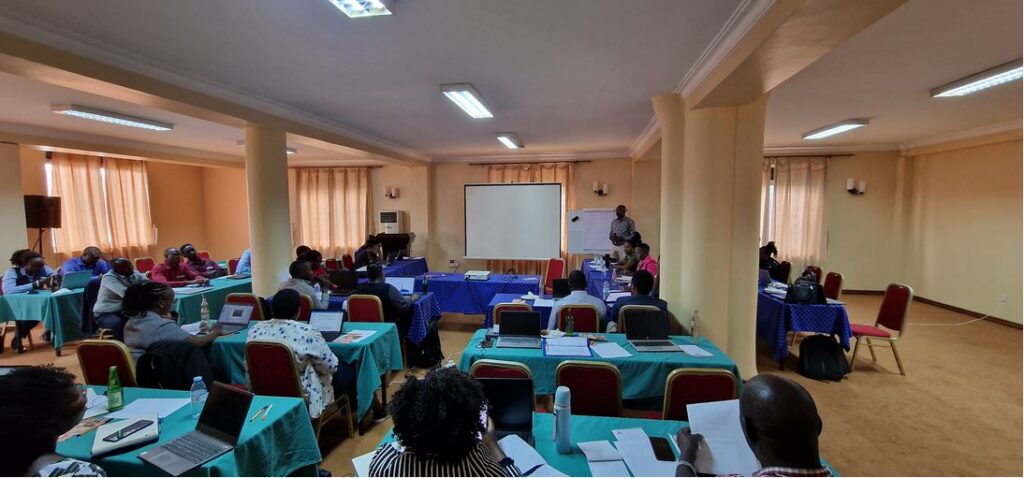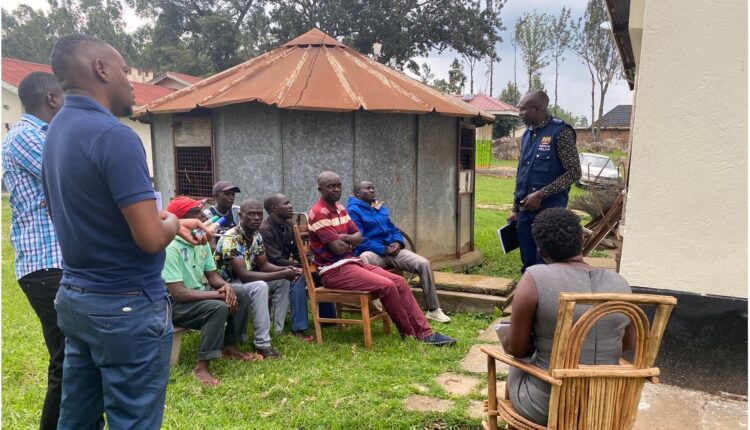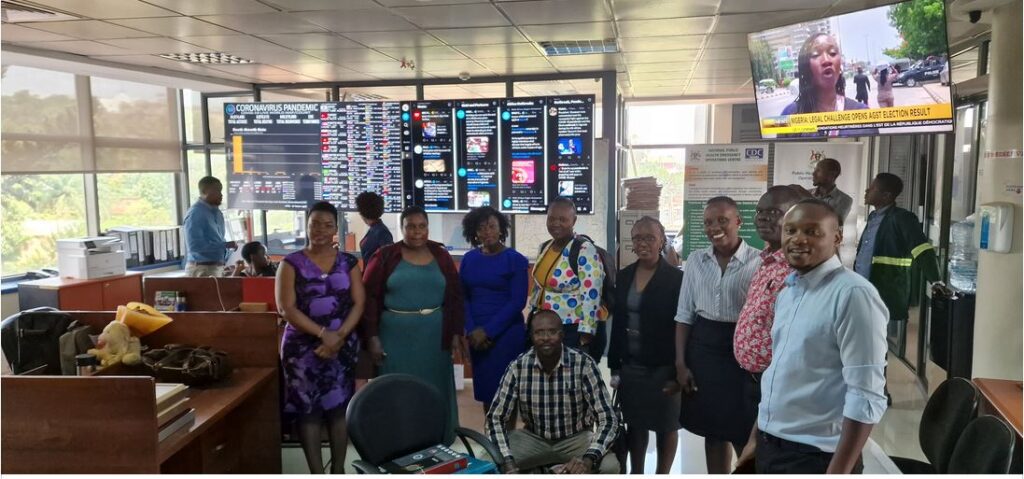
How Uganda Traced Population Movement to Combat Ebola
On June 14 2023, Uganda’s National Institute of Public Health along with their Ministry of Health adapted a border health surveillance tool to help case investigation and drive better and faster decision-making during the outbreak.
On September 20, 2022, experts from Uganda’s Ministry of Health (MOH) and National Institute of Public Health (NIPH) were in the middle of a joint training session on border health surveillance with their Kenyan and Rwandan counterparts when they received notice that an outbreak of Ebola virus disease (EVD) had been declared by the MOH. A patient in Mubende district in Central Uganda had been confirmed by the Uganda Virus Research Institute to have Sudan ebolavirus. “Immediately, several colleagues had to leave for Mubende to support the response,” said Dr. Harriet Mayinja, the focal person for border surveillance at the MOH. At the time, Dr. Mayinja was overseeing the training.
This was the first time in over a decade that Uganda reported an outbreak of the Sudan ebolavirus. The outbreak became the second-largest EVD outbreak in the country with 142 confirmed cases and 55 deaths among the confirmed cases. Beyond Mubende District, the virus had spread to eight other districts – Bunyagabu, Kagadi, Kampala, Kassanda, Kyegegwa, Jinja, Masaka, and Wakiso. “The spread was fueled by population mobility,” said Dr. Mayinja. “We needed to understand the movement patterns of EVD cases and their contacts to improve our surveillance and response efforts.”

As part of a project to strengthen Uganda’s border health capacity, the NIPH and the MOH had been working to implement a population-mapping tool called PopCAB, with the support of the IANPHI and the U.S. Centers for Disease Control and Prevention (CDC). PopCAB, which stands for ‘Population Connectivity across Borders’, was created by U.S. CDC to collect information on and analyze population mobility patterns, including the types of travelers moving through an area, the routes taken, and the reasons for travel, to inform public health interventions. Carrying out PopCAB includes holding focus group discussions and key informant interviews, each including a participatory mapping component. Results are combined to create annotated maps showing travel routes and points of interest. Public health practitioners complete rapid data collection and analysis employing qualitative and quantitative methods to support outbreak response in real-time. PopCAB can also be carried out over longer periods for longitudinal analyses in non-emergency settings. “The introduction of PopCAB in Uganda started with the 2018 Ebola outbreak in the DRC [Democratic Republic of Congo], which spilled over in Uganda. We conducted preparedness assessment, risk mapping, which enabled us to track population movement quite effectively,” explained Dr. Alex Riolexus Ario, director of NIPH and chair of the IANPHI African Network.
Dr. Mayinja and her colleagues, including fellows from the Uganda Public Health Fellowship at NIPH, adapted PopCAB to quickly identify key locations, routes, modes of transportation, and reasons for travel through key informant interviews with EVD cases and their contacts. They asked about points of interest visited, social events attended, healthcare facilities visited, links between locations (travel patterns, mode of transportation, sequence of events at locations), and reason for movement. The data generated were overlaid on an existing Uganda map. Both the qualitative and spatial data were used to target and prioritize areas for enhanced surveillance, risk communication, and infection prevention and control measures.

Supporting case investigation and contact tracing
The qualitative data generated through PopCAB supported case investigation, providing more insights into new transmission chains, especially in areas outside the initial outbreak district of Mubende. “For example, PopCAB data helped us link Muwanguzi – a pseudonym – who was one of the first confirmed cases in Kampala, to existing transmission chains in Mubende and identify the numerous places where Max had sought care, including a shrine in Luweero District,” said Dr. Mayinja. “It provided precious insights into health-seeking behavior for EVD.”
Spatial data obtained from PopCAB also guided EVD contact tracing. Linkages between movement and symptom status helped identify high-risk contacts – people who had had contact with cases while they were symptomatic. “The unique approach of the PopCAB methodology allowed us to identify contacts who had no obvious relationship with cases, but had been exposed in public transportation and public places like the markets,” said Dr. Mayinja. “For example, the contacts of Kitibwa – also a pseudonym – who were exposed to him at a bar were identified by mapping his movement patterns.”
The PopCAB maps were used to visualize data and identify new hotspot areas, which facilitated decision-making for the allocation of medicine and health workers. Key locations of interest identified during PopCAB such as markets, places of worship, and places of entertainment were also prioritized for risk communication. In Kampala, PopCAB findings informed increased risk communication efforts in areas reported to be visited by EVD cases and their contacts. PopCAB also helped target health facilities for reinforced infection prevention and control measures. “The application of the PopCAB methodologies facilitated the provision of vital real-time information necessary for improving surveillance and response,” said Dr. Mayinja.
An after-action review was conducted in February 2023 at the national and subnational levels in the affected districts to assess the response and document best practices, gaps, and lessons learned. NIPH helped facilitate discussions with first responders, government officials, partners, and in-country and foreign observers. One of the recommendations from the review was to continue to train public health practitioners on PopCAB all over the country, and to implement ZooCAB[1] to trace animal movement which may contribute to zoonotic disease spread.
“The training of officers in PopCAB opened another avenue. We are using PopCAB for other responsibilities in the country and across borders,” said Dr. Ario.

In March 2023, NIPH and the Ministry of Health conducted a PopCAB exercise near the border with Tanzania as Uganda’s neighbor was responding to an outbreak of Marburg virus disease. The exercise identified high-risk areas to which cases from Tanzania might travel – as well as routes used – in southern Uganda; these areas were then prioritized for additional surveillance. The use of PopCAB for border health surveillance is part of a broader effort by NIPH to strengthen capacities for point-of-entry (PoE) surveillance, in accordance with the 2005 International Health Regulations. The Ugandan government adopted a National Action Plan for Health Security to address gaps identified in a Joint External Evaluation by the World Health Organization in 2017. The country has made significant progress since then. Today the MOH manages 53 PoEs, including eight designated PoEs with core capacities, such as isolation centers, health facilities, and ambulance services. The Ugandan health authorities routinely collect information on the flow of population crossing the borders and the routes that are used.
“If we have another outbreak, we will have more robust information informing how to respond to it effectively,” concluded Harriet Mayinja.

1] ZooCAB was piloted in Uganda in 2020: https://www.ncbi.nlm.nih.gov/pmc/articles/PMC8518851/
Reference to: https://ianphi.org/news/2023/uganda-ebola-response.html
